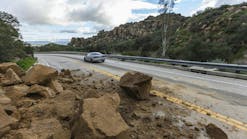Will Segmental Walls Work Everywhere?
Dick Stulgis, vice president of the environmental and underground consulting engineering firm Haley & Aldrich in Manchester, NH, says his firm mainly designs reinforced-soil segmental walls wherever a retaining wall is needed.
At a major supermarket site near Manchester, a 30-foot-high, 500-foot-long retaining wall was needed near the rear of the property. Haley & Aldrich considered a conventional reinforced-concrete retaining wall, a steep geogrid-reinforced slope with vegetative cover, or a geogrid-reinforced segmental wall.
The concrete wall, Stulgis says, was much too expensive and therefore rejected. Although the reinforced slope cost 20% less than the segmental wall, the owner rejected that option.
Stulgis maintains that the segmental retaining wall is less costly than a concrete wall from 4 to 50-plus feet high, and the percentage of savings over the reinforced-concrete wall increases as the wall height increases. He uses either geogrid or geofabric. Although fabric is less expensive, Stulgis believes geogrid manufacturers have convinced many owners that the connection strength is better. He notes that the connection strength between soil reinforcement and segmental block is important, especially on high walls. The segmental wall is similar to the curtain wall on a building: The building’s frame carries the heavy loads, but the curtain wall still has to be firmly attached.
Stulgis has had to build a retaining wall where neither a cantilevered concrete wall nor a segmental wall works. Recently, Haley & Aldrich was hired by the New Hampshire Department of Transportation to widen a stretch of Kancamagus Highway in the White Mountains National Forest near Albany, NH. The project entailed cutting into the toe of a steep mountainside, possibly causing a slide. In this case, Haley & Aldrich used soil nails and shotcrete, building the wall from the top down. They excavated down 5 feet, drilled soil nails into the embankment, grouted into the annular space between soil nail and soil to fix the nails permanently, and then sprayed the exposed vertical face with a 4- to 12-inch layer of shotcrete. The workers repeated this process in 5-foot increments until the entire 20-foot-high wall was completed.
Stulgis believes that segmental walls are too often designed by unqualified people. Frequently they zero in on the design of the wall and reinforcing zone only, paying little attention to the actual soil conditions at the site. Such a myopic subsystem approach is a formula for failure. The wall designer, says Stulgis, must consider both soil conditions and water flows. The best precaution is for the owner or his agent to retain a qualified, successful geotechnical engineer to design the wall system, he emphasizes.
US Army Corps: Slow to Adopt Segmental Walls
Neil Schwanz, a geotechnical engineer with the St. Paul District of the US Army Corps of Engineers, says his district has constructed a dozen segmental retaining walls along the banks of rivers and reservoirs in the past decade. Because of that experience and because it designs structures for a lifetime of 100 years or more, the corps has not yet made a full commitment to segmental walls. It still has more confidence in using cast-in-place concrete and anchored steel sheet piles for walls along riverbanks and lakeshores, Schwarz states. With more favorable field experience, he believes, the corps will build many segmental walls in the future, especially given their 50-70% cost savings over the alternatives.
One test installation lies along the Zumbro River as it passes eastward through Rochester, MN, 60 mi. south of Minneapolis, where the river periodically floods. The corps’ solution was to increase the cross-sectional area of the river by excavating its bottom and banks, Schwanz explains. Where buildings were close to the river, the banks had to be graded to a steep slope or else replaced with vertical retaining walls.
The corps has decades of experience with cantilevered concrete walls along waterfronts. Its disadvantages include having to excavate into the embankment to construct the base-slab cantilever, waiting for concrete to cure, high cost, and cracking caused by freeze-thaw.
The corps also has extensive experience with anchored steel sheet-pile retaining walls usually constructed along waterfronts where there is insufficient room to install a cantilevered concrete or reinforced-soil segmental wall. Once the steel sheet piles are in place, 30-ft.-long steel anchors are driven through and grouted to bolster the piles against lateral earth pressures. Where necessary, these anchors are driven beneath the foundations of nearby buildings. The corps is confident such an installation will last at least 100 years–even when the piles have no protective coating. A major advantage to this kind of wall is that it can be built where space is limited. Major disadvantages include high cost and poor aesthetics.
In 1993, the corps constructed a 700-ft. stretch of reinforced-soil segmental wall along the waterfront in Rochester, MN. To date, Schwanz observes, the wall shows no sign of deterioration. Such walls have promise for the corps because of lower cost, speed of construction, and appearance.
Schwanz notes that the corps designers assumed water would penetrate the wall and saturate the reinforced-soil zone. They used geogrid placed in horizontal planes 2 feet apart. Schwanz says geogrid was designed specifically for a soil-reinforcing application but geofabric was not. There is concern that geotextile fabric could stretch or creep over time. He argues that it is important to use a clean sand backfill containing no silts or clays because of the saturation threat along rivers and waterfronts. It is important that the reinforced zone drain quickly after the water recedes because trapped water adds weight to the backfill and is subject to freeze-thaw action.
Schwanz mentions these important considerations:
Use a Clean Sand Backfill. Gravel backfill also allows drainage but might damage the geogrid if compacted. The solution is to use more geogrid than needed.
Avoid Using a Segmental Wall Where Large Ice Chunks Float in Rivers or Lakes During Winter. If they collide into the fragile segmental wall, it will be damaged. In this case it is better to use a sheet-pile or reinforced concrete wall.
Compact Backfill Often. If using a vibratory compactor, compact in lifts of 6-8 inches; if using a hand tamper, compact in 4-inch lifts.






